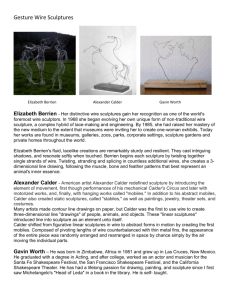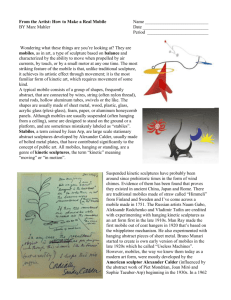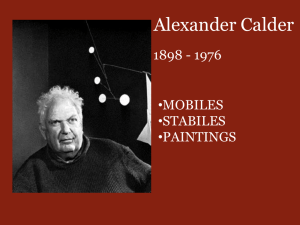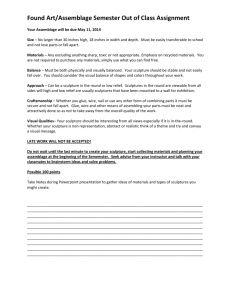Kinetic Definition
advertisement
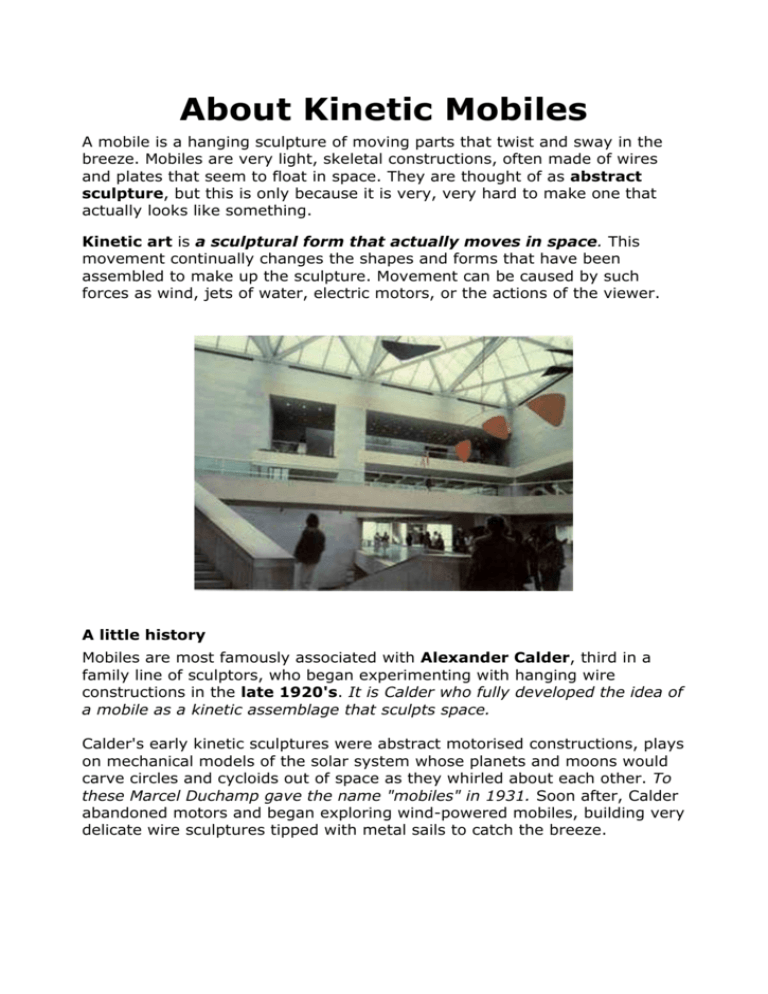
About Kinetic Mobiles A mobile is a hanging sculpture of moving parts that twist and sway in the breeze. Mobiles are very light, skeletal constructions, often made of wires and plates that seem to float in space. They are thought of as abstract sculpture, but this is only because it is very, very hard to make one that actually looks like something. Kinetic art is a sculptural form that actually moves in space. This movement continually changes the shapes and forms that have been assembled to make up the sculpture. Movement can be caused by such forces as wind, jets of water, electric motors, or the actions of the viewer. A little history Mobiles are most famously associated with Alexander Calder, third in a family line of sculptors, who began experimenting with hanging wire constructions in the late 1920's. It is Calder who fully developed the idea of a mobile as a kinetic assemblage that sculpts space. Calder's early kinetic sculptures were abstract motorised constructions, plays on mechanical models of the solar system whose planets and moons would carve circles and cycloids out of space as they whirled about each other. To these Marcel Duchamp gave the name "mobiles" in 1931. Soon after, Calder abandoned motors and began exploring wind-powered mobiles, building very delicate wire sculptures tipped with metal sails to catch the breeze. Mobile construction Mobiles are a difficult medium. It can be quite hard to make a mobile look "as intended." Where the masses will float in space, how long the wires are, and where the fulcrums wind up are largely dictated by the mechanics of balance. This is probably why nearly all mobiles are abstract and not representational. Inside-out construction Calder said he usually meant to make one thing and wound up making another. He built his mobiles from the inside out, first looping and hooking a wire, then looking for a spot along its length where a weight would balance. If you go to a museum and you can see traces of his trial-and-error method in the way he clipped wires and stapled on weights wherever he found a favourable balance. Occasionally he built two or three models of the same mobile, trying to find a set of balance points that would allow him to place the weights exactly where he wanted them to float in space. Outside-in construction Alternatively, you can build a mobile from the outside in: Choose where the weights will float, sketch wires, estimate balance points, and repeatedly revise the wires until they pass through their balance points. Because the wires have mass, revisions change the balance points, making outside-in method rather painstaking. However, because it allows much more control over what the mobile will actually look like, it opens the door to a realm of much more expressive and representational kinetic sculptures. This mobile is a representation of my Siamese cat "Snoop Kitty Kit". I start out by making all the parts from German Silver and anodised aluminium wire. After I solder it all together, the pieces are balanced and attached to the frame. When the body is done, the eyes, whiskers and tags are added. Hang this one from your ceiling and watch it play in the breeze. The finished piece is approximately H x W x D = 10 x 5 x 8in Robert Harrison Welcome to the whimsical world of wire mobiles and kinetic sculptures. A metalsmithing class at the University of Oregon in Eugene introduced Robert Harrison to wire sculpture. From there he began his sculptured mobile art. Robert's mobiles suggest a variety of subjects from abstract to comical to human faces with "thoughts" in their heads, to our solar system. Alexander Calder first popularised mobiles beginning in the 1920's and continued to create them all the way up to the 1970's. On average he created one piece of artwork everyday for 50 years. In fact, Calder created more than 16,000 items. The main body of his work was mobiles, stabiles, paintings, sculptures and jewellery.

